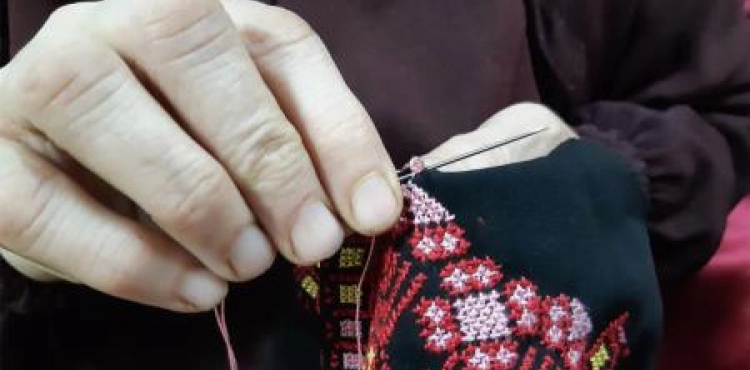is the last piece in a garment that will see the light soon overflowing with beauty in its bright and calm colors. The fingers of Ibtisam Jaber´s fingernail flirted him with a special needle, and hit his stitches one by one, to show with them the shape you want in harmony and symmetry At work lasted for several weeks or months.
The dress prepared by Ibtisam, 54, in the Balata refugee camp in the city of Nablus, adds a new line in the refugee story, linking it to the reality that grandparents lived in a sweet and bitter time before the catastrophe.
On the way to the home of Ibtisam, we searched between the camp´s similar alleys and its adjacent houses, to show us through words written on the walls and pictures of hung martyrs and prisoners that narrate the suffering of the country.
Ibtisam grabs a needle packed with the best DMC embroidery thread, as she says, then stitches the embroidery in harmony with each other.
Narration of place and color
Ibtisam prepares her works by telling the camp and refugee tales in it. Every work weaves its strings with the story of its original place in the historic villages and cities of Palestine; The red color denotes the Sahel region in Jaffa, Haifa, and Acre, where the anemones bloom, the violet has mountain glow, and white mixed with blue reflects the calm of Lod and Ramla cities.
"From my grandmother and from the camp women who have lived in the Nakba, I weave my embroidery from dresses, antiques, pendants, and even some home furniture," says Ibtisam as she manipulates her fingers between the needle and thread to insert it into the cloth to produce the piece she wants.
The "Palestinian peasant" embroidery has different shapes and colors that return to its original homeland, and the single stitch also varies between "hitting", "octagonal", "machetes", and others.
As for its shape, it is known as pink, peacock, the far, sun, flag, butterfly and horse. In an image that reflects the beauty of the Palestinian land and its biological and biological diversity, there are veins that surround the embroidery length or width, "and it is the most difficult thing to do."
From home, Abu Jaber started producing embroidery and prepared for herself and her daughters the clothes, costumes, antiques, pendants and some furniture as well, then expanded her idea through large projects implemented through the camp institutions, and transferred the experience to women who marketed their work locally and globally.
Ibtisam says that her work in embroidery made her productive under a difficult economic situation that the camps, especially women, suffer from, and established her conviction that the return that she embodied in her work is close, and that is why the walls of her house, like the homes of the camp, are covered with various forms of embroideries from the time of the Nakba or modern times. The ones and the factory are fragrant past.
Ibtisam also "restored" the old embroideries that she collected from here and there and from the elderly, to fix them completely, such as garments or partially, to transform them into antiques and pendants in which to keep their original habitat. ".
Embroideries for all occasions
We touched this past in the garment of need, Yusra Qallab (Umm Shaaban), who is stepping towards us, telling us her old dress, which she made six decades ago and is still preserved by its luster and beautiful beauty, says Umm Shaaban (90 years), who lives near Ibtisam; She trained to embroider in the yard of their house in the village of Salamah in the occupied interior, where her mother and grandmother embroidered garments and household furniture such as sheets, bed linen and others.
Umm Shaaban responds to the question of one of her neighbors in the alley of the camp about the secret of her wearing the dress in the presence of the press? The old woman responds joking that someone wants to propose marriage to her and asked for her photo in advance, but she remembers that she used to wear the dress permanently, but now she is confined to weddings and national and traditional occasions, "and that is why I made another dress in the color of the Palestinian flag."
And for the need side, Ibtisam and Um Shaaban, the young woman, Nour Awda, specializes in wedding embroideries more than others. She says, referring to the Palestinian wedding plate hanging in the front of her house, and beside her trays decorated with beads; It works to make embroiderments a tradition and a permanent dress, "especially since it carries innumerable tales."
Identity preservation
In Balata camp, like all camps, embroidery narratives meet with their subtle details to form a coordinated mosaic painting that motivated the civil institutions in it to exploit the unemployment of women there and create a link with their countries of origin through their work.
Samira Amira, from the Balata Camp Services Committee, says they have dedicated a whole corner of the committee to embroideries, with the aim of preserving the historical identity of Palestine on the one hand, and providing job opportunities for about 10% of the camp´s women who lose work, so their role as an institution lies in providing work for women and marketing the product.
In an attempt to adapt the embroideries to modernity and encourage the generation to acquire them to enhance their knowledge of their heritage and importance, Amira says that they resorted to "vaccinating" modern clothes, especially shirts, with embroideries to beautify them and preserve their national identity.
The refugees repeat the saying that the camp is nothing but a transit station to return to their original homes, and it is also in the eyes of Umm Shaaban, who recommended her embroidered dress to her neighbor, Ibtisam, to keep it as it saved others for the day to return to the "country" which is around the corner or less, she says.












